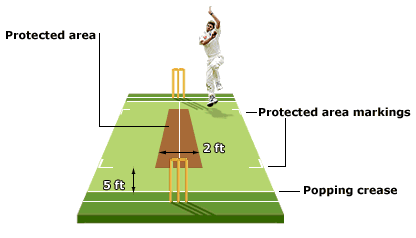A bowler in cricket is a player, who has the responsibility of taking wickets and getting the opposition out for as low a total as possible. Bowling in cricket is an act of propelling the ball towards the batsman who is standing at the other end to face the ball.
A bowler bowls a set of six balls which makes it an over after which the other bowler comes in, to bowl his six deliveries.
Delivery is an act of bowling the ball to the batsman.
Just like other sports, cricket too has its own set of laws which as
per which the game runs.
If a bowler has bowled an illegal delivery, then it will be termed as a no-ball, while if he bowls outside of the reach of the batsman, it will then be considered as a wide ball.
DIFFERENT TYPES OF BOWLERS
1. Fast Bowlers:
Fast bowlers are the one who bowls fast. Pace on the ball is their USP. They terrify batsman with their pace and pick wickets with their nasty bouncers and jaw-dropping yorkers.
2. Seam and swing bowling
Although they lack speed, they know how to make the ball talking by deviating it in the air. Doing this makes it even tougher for batsmen to face it.
3. Spin Bowler
A spin bowler would deliver the ball slowly in the air and would turn it while bouncing off the surface. A spin bowler becomes dangerous when he has 5-6 kinds of variations in his armoury.
History:
During the initial days of cricket, bowlers used to bowl underarm and it continued until round-action came in the 1800s.
John Willies is said to be the first bowler who came up with the idea of round-arm action. The technique though was first used by his sister Christina who once couldn’t ball under-arm as she was wearing a wide dress.
The Marylebone Cricket Club, initially, discarded the idea but finally accepted in 1835 and underarm slowly disappeared from the game. Although, it was banned in 1981.
WHAT’S THE OBJECTIVE BEHIND BOWLING?
In the game of cricket, the aim behind bowling the deliveries is to take wickets. The bowlers have the responsibility to claim the wickets of all the eleven players play in the opposition’s team.
Adding to that, bowlers also have the job to keep the batting side’s run rate as low as possible so that they can restrict the opposition to the least possible total. And that can be possible when the bowlers pitch the ball in the right areas and pick wickets at regular intervals.
In a bid to pick wickets, the bowling side plays with a different variety of bowlers, taking into consideration what pitch offers in the match.
WHAT ARE THE TYPES OF DISMISSALS IN THE GAME OF CRICKET?
Under the bowling rule in cricket, a bowler can dismiss a batsman in various ways. Let’s look at a few of those:
1. Caught
If the ball faced by the batsman is caught by the bowler when being touched at the ground, he will be judged as “caught out”.
2. Bowled
If a bowler rips apart batsman’ wicket with the ball, he will be judged as “bowled out”.
3. Leg Before Wicket
The batsman is out “leg before wicket” (lbw) if he intercepts with any part of his (except his hand) that is in line between wicket and wicket a ball that has not first touched his bat or his hand and that has or would have pitched (hit the ground) in a straight line between the wickets or on the off-side provided the ball would have hit the wicket. The batsman may also be out lbw if he intercepts the ball outside the off-side stump having made no genuine attempt to play the ball with his bat.
4.“Stumped”
A batsman can be out stumped if he pops out of his crease while batting and the wicket-keeper dislodge the bails before the batsman comes back to the crease.
RULES OF BOWLING:
1. Bowlers throwing rather than bowling will be termed as Illegal:
What is an illegal bowling action?
Whenever a bowler throws the ball instead of bowling, it will be termed as illegal and will be suspended from bowling in cricket.
While bowling, if a player extends his arm and the umpire deems that the ball has been thrown then it will be considered as a no-ball the bowler won’t be allowed to bowl further in the match.
Illegal bowling means that the bowler won’t be allowed to bowl until he modifies it and get it approved from ICC.
2. No Ball rule:
It is important for every bowler to notify the umpire before starting his over that whether he will bowl right-handed, left-handed, over the wicket or round the wicket. This way the umpire will inform the batsmen. If the bowler fails to do so, then the umpire has the right to give no-ball.
If a bowler tried to bowl an underarm delivery, it will be termed as a no-ball. The umpire then is supposed to give a first and final warning to the bowler. The under-arm bowling rule was abandoned in the year 1981.
Under another bowling rule in cricket, if a bowler throws the bowling to the batsmen before reaching his delivery stride, it will be termed as a no-ball.
Also, if a ball bounces twice or more than that along the ground before it reaches the popping crease, it will be considered as a n-ball.






